Administering Snort with HenWen
Problem
You need to administer Snort on a Mac OS X machine.
Solution
There are two possible ways to administer Snort on a Mac OS X machine, depending on the way you installed Snort. If you installed by compiling the source code, you would administer it the same as on any other Unix machineby editing the configuration files directly. However, if you installed Snort by using the HenWen packages described in Chapter 1, you can use HenWen to carry out further administrative tasks.
Discussion
HenWen provides a GUI interface to most of the Snort configuration options. Once it is installed, double-click on the HenWen icon to bring up the interface. Each time it is run, you see the Welcome screen asking for registration. If you are going to be running HenWen within a commercial setting, you are obliged to pay the shareware fee to help fund further development; any other situation is free of cost (Figure 5-44).
Figure 5-44. HenWen Welcome screen
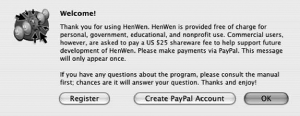
Clicking OK will bring up the Network configuration main screen (Figure 5-45). It may also bring up an error telling you that the Snort daemon is not running, which is fine, because it isn't yet (Figure 5-46). The Quit button is somewhat misleading, as it doesn't quit the application; it only closes the window.
Figure 5-45. HenWen network configuration

Figure 5-46. ErrorSnort daemon is not running
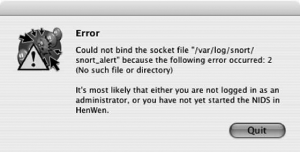
There are six main tabs in the HenWen interface: Preprocessors, Output, Alerts, Snort, Spoof Detector, and Network. As previously shown, you start in the Network tab. This screen defines the network properties of the Snort daemon. The first defined property is the interface on which Snort will listen, followed by a checkbox to determine whether the interface should be put into promiscuous mode. If you are only concerned about traffic to or from the host on which you are running, there is no need to make the card promiscuous; this will also increase the system's efficiency. Also, today's switched networks protect against promiscuous mode, so you will have to either make a setting change in the switch to allow it or use a hub or tap.
Next, you can specify values for your network, such as the ranges of the internal and external network, specific servers, and some port configuration options for specific services. You should set the details to reflect your configuration, as this will increase the efficiency of the Snort daemon, monitoring only relevant traffic, rather than all traffic.
At the very bottom of this tab are the Start NIDS and Stop NIDS buttons that allow you to start and stop the Snort daemon. If you make any configuration changes, you must stop and restart the daemon for those changes to take effect.
Starting at the other end of the tab list, we have the Preprocessors tab (Figure 5-47). Here, you can see options to set the preprocessors that are described in previous chapters, and also the settings for Spade, which HenWen contains precompiled. Read the other recipes on the preprocessors, and enable those that are appropriate to your environment. Remember though: each preprocessor enabled adds overhead on performance, so enable only those that you know you need. The default set is quite reasonable.
Figure 5-47. HenWen preprocessor configuration
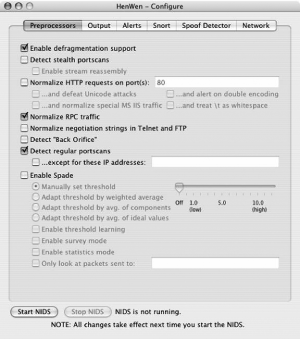
Next is the Output tab (see Figure 5-48). In this tab, you can alter your logging options, including setting up logging to a database. If you are going to use LetterStick for alerting, you'll need to enable the Log alerts to a Unix socket checkbox here.
Figure 5-48. HenWen output configuration
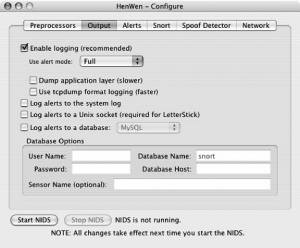
The next tab is Alerts. This is where you select the rules to be scanned against. You can add, delete, and edit rules here (Figure 5-49).
Figure 5-49. HenWen alerts configuration
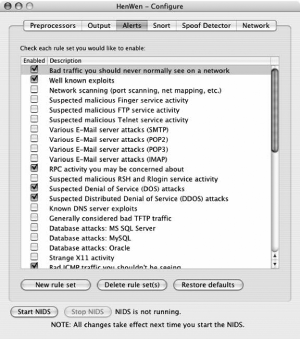
The Snort tab contains settings for Snort itself (Figure 5-50). You can select the detection engine to be used and set up the various decoder options.
Figure 5-50. HenWen Snort configuration

The final tab contains the settings for the Spoof Detector. This enables detection of ARP poisoning and spoofing attacks (Figure 5-51).
Figure 5-51. HenWen Spoof Detector configuration
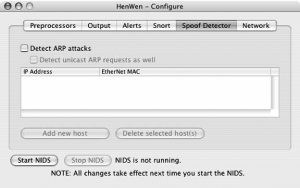
HenWen is very straightforward to useit just provides an easy-to-use graphical interface to all the Snort options. You should refer to the remainder of the book and other reference sources to determine which options you need to use. Once you know, it becomes a matter of selecting a checkbox rather than editing the text configuration files.
See Also
Recipe 1.6
http://seiryu.home.comcast.net/henwen.html
Newbies Playing with Snort Using EagleX |
Installing Snort from Source on Unix
- Installing Snort from Source on Unix
- Installing Snort Binaries on Linux
- Installing Snort on Solaris
- Installing Snort on Windows
- Uninstalling Snort from Windows
- Installing Snort on Mac OS X
- Uninstalling Snort from Linux
- Upgrading Snort on Linux
- Monitoring Multiple Network Interfaces
- Invisibly Tapping a Hub
- Invisibly Sniffing Between Two Network Points
- Invisibly Sniffing 100 MB Ethernet
- Sniffing Gigabit Ethernet
- Tapping a Wireless Network
- Positioning Your IDS Sensors
- Capturing and Viewing Packets
- Logging Packets That Snort Captures
- Running Snort to Detect Intrusions
- Reading a Saved Capture File
- Running Snort as a Linux Daemon
- Running Snort as a Windows Service
- Capturing Without Putting the Interface into Promiscuous Mode
- Reloading Snort Settings
- Debugging Snort Rules
- Building a Distributed IDS (Plain Text)
- Building a Distributed IDS (Encrypted)
Logging to a File Quickly
- Logging to a File Quickly
- Logging Only Alerts
- Logging to a CSV File
- Logging to a Specific File
- Logging to Multiple Locations
- Logging in Binary
- Viewing Traffic While Logging
- Logging Application Data
- Logging to the Windows Event Viewer
- Logging Alerts to a Database
- Installing and Configuring MySQL
- Configuring MySQL for Snort
- Using PostgreSQL with Snort and ACID
- Logging in PCAP Format (TCPDump)
- Logging to Email
- Logging to a Pager or Cell Phone
- Optimizing Logging
- Reading Unified Logged Data
- Generating Real-Time Alerts
- Ignoring Some Alerts
- Logging to System Logfiles
- Fast Logging
- Logging to a Unix Socket
- Not Logging
- Prioritizing Alerts
- Capturing Traffic from a Specific TCP Session
- Killing a Specific Session
How to Build Rules
- How to Build Rules
- Keeping the Rules Up to Date
- Basic Rules You Shouldnt Leave Home Without
- Dynamic Rules
- Detecting Binary Content
- Detecting Malware
- Detecting Viruses
- Detecting IM
- Detecting P2P
- Detecting IDS Evasion
- Countermeasures from Rules
- Testing Rules
- Optimizing Rules
- Blocking Attacks in Real Time
- Suppressing Rules
- Thresholding Alerts
- Excluding from Logging
- Carrying Out Statistical Analysis
Detecting Stateless Attacks and Stream Reassembly
- Detecting Stateless Attacks and Stream Reassembly
- Detecting Fragmentation Attacks and Fragment Reassembly with Frag2
- Detecting and Normalizing HTTP Traffic
- Decoding Application Traffic
- Detecting Port Scans and Talkative Hosts
- Getting Performance Metrics
- Experimental Preprocessors
- Writing Your Own Preprocessor
Managing Snort Sensors
- Managing Snort Sensors
- Installing and Configuring IDScenter
- Installing and Configuring SnortCenter
- Installing and Configuring Snortsnarf
- Running Snortsnarf Automatically
- Installing and Configuring ACID
- Securing ACID
- Installing and Configuring Swatch
- Installing and Configuring Barnyard
- Administering Snort with IDS Policy Manager
- Integrating Snort with Webmin
- Administering Snort with HenWen
- Newbies Playing with Snort Using EagleX
Generating Statistical Output from Snort Logs
- Generating Statistical Output from Snort Logs
- Generating Statistical Output from Snort Databases
- Performing Real-Time Data Analysis
- Generating Text-Based Log Analysis
- Creating HTML Log Analysis Output
- Tools for Testing Signatures
- Analyzing and Graphing Logs
- Analyzing Sniffed (Pcap) Traffic
- Writing Output Plug-ins
Monitoring Network Performance
- Monitoring Network Performance
- Logging Application Traffic
- Recognizing HTTP Traffic on Unusual Ports
- Creating a Reactive IDS
- Monitoring a Network Using Policy-Based IDS
- Port Knocking
- Obfuscating IP Addresses
- Passive OS Fingerprinting
- Working with Honeypots and Honeynets
- Performing Forensics Using Snort
- Snort and Investigations
- Snort as Legal Evidence in the U.S.
- Snort as Evidence in the U.K.
- Snort as a Virus Detection Tool
- Staying Legal
Index
EAN: 2147483647
Pages: 167
